| Please add updates@feedmyinbox.com to your address book to make sure you receive these messages in the future. | |
| Connecticut Attorney General Leads 30-State Investigation Into Google "Data Grab"
June 22, 2010 at 1:01 PM
|
|  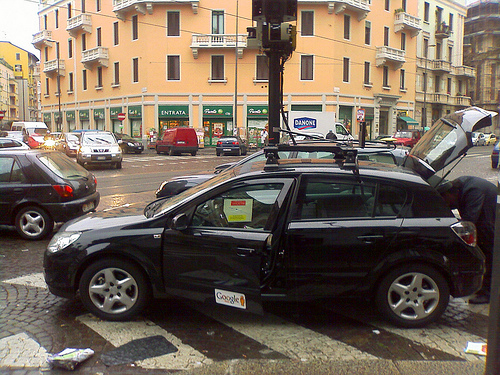
Connecticut's Attorney General, Richard Blumenthal, is leading a multi-state investigation into Google's admitted breach of wireless privacy. You can check out our coverage of the situation, but to quickly catch you all up: Google's Street View cars, while doing their normal mapping, also gathered data on local Wi-Fi networks. This has a legitimate purpose--Google says it's for location services, which could include, say, an overlay in Google Maps showing all the local cafes with free Wi-Fi. But the Street View cars did their job entirely too well, gathering information on private Wi-Fi networks as well as public, even sniffing out some passwords and emails. Google claims this was completely unintentional, has cooperated fully with all authorities (and there have been lots of interested authorities, at home and abroad), and contritely apologized for the violation. Now, reports Reuters, Blumenthal is leading the charge with several other states--he conducted a conference call with "over 30 states"--to investigate further Google's "deeply disturbing invasion of personal privacy," as he puts it. His investigation will seek to find out what, if any, laws were broken, and if current state and federal statutes may need updating in response. Blumenthal says Google has cooperated fully, but "its response so far raises as many questions as it answers." Blumenthal (or, at least, Reuters) did not elaborate on what questions Google's response has raised. The Connecticut AG is seeking more information into how this mistake did actually happen, which is something we'd all like to know. Cracking personal Wi-Fi passwords isn't exactly automatic (though it is easier than many think), and it's very curious that such code made it into the Street View cars. A Google spokesman responded: It was a mistake for us to include code in our software that collected payload data, but we believe we did nothing illegal. We're working with the relevant authorities to answer their questions and concerns."Dan Nosowitz, the author of this post, can be followed on Twitter, corresponded with via email, and stalked in San Francisco (no link for that one--you'll have to do the legwork yourself). 

 | | |
| How to Create a "Godly" Game Opening
June 22, 2010 at 3:00 AM
|
|  How do you create the opening credits for a beloved game franchise, telling a story in a unique way, but keeping the feel of the franchise? Below I recount how we at Imaginary Forces worked on God of War III. The game's director Stig Asmussen and the team at Sony Computer Entertainment really pushed us to create an aesthetic that would complement the highly-rendered world that makes up most of the game. More below. 

 | | |
| Space Hero Glenn: Save Our Space Shuttles
June 22, 2010 at 6:54 AM
|
|  
If, like me, you're a fan of all things space-related, then this year's grounding of the Space Shuttle fleet is a tricky thing--sensible, and yet a poignant tragedy. Now the biggest voice yet has joined the pro-Shuttle debate: John Glenn. If you don't know that name, then shame on you: He was the third person in space, and the first American to orbit Earth as part of NASA's historic Mercury program in 1962. After retiring from NASA he "dabbled" in politics, winning a 25-year seat in the Senate representing Ohio, until 1999. In 1998 he became the oldest person yet to fly to space, as a working crew member aboard Space Shuttle Discovery. In other words, this man knows what the heck he's talking about, from a technological, explorational, and political point of view. His words carry weight. And his words about the Shuttle's planned retirement to "make way" for NASA to develop its successor unhindered by having to support the aging Shuttle systems are stark. Speaking to the AP Glenn's message is very simple: "We have a vehicle here, why throw it away? It's working well." Glenn also thinks that the fact that in the interim between Shuttle flights and a viable successor human-rated heavy lift rocket NASA will have to pay Russia to fly its people into the void "doesn't sit right" with him and probably many Americans either. It's a viewpoint that's a tad jingoistic, harking back to the Cold War and space race of old, but Glenn has a point--one of the wonderful halo effects of the U.S. space race successes was a rush of excitement in all things space-related, and a boost in enthusiasm for science that is arguably responsible for many current U.S. tech successes. Resigning the ride to space to your once-foes for so many years is simply not going to stir up the public's U.S. science feelings--and the money could easily be spent flying one or two Shuttles per year. In some sense, Glenn's position echoes what many said at the end of the Apollo program--the ridiculously successful enterprise that put men on the moon. At the end of Apollo, everything was scrapped to make way for the Shuttle. And yet there were proposals on the table to develop the Saturn V rocket tech to a point where the entire International Space Station could've been launched in a single shot, decades ago. The argument supporting this is that you take a short-to-medium term financial hit to benefit from a massive long term gain: Think of how much more advanced space science, and medicine would be, if a Saturn derivative had launched the ISS in the 1980s. And then extrapolate that notion to keeping the Shuttle aloft until a successor, possibly based on Shuttle tech is fully certified. Glenn's concern is also that an accident may befall the Russian Soyuz system, grounding the rockets and forcing abandonment of the billion-dollar ISS--a position from which it could probably never be rescued. 
As for the Obama-led push to develop the U.S.'s commercial space industry, Glenn is "leery" of it. You may well think he could be little else, with a career in the military and a long history in NASA somewhat institutionalizing him into ideas about "how it should be done." But you can't argue with his sentiment and position on the costs involved. All we have to see know is if Obama has the stones to respond with some meaningful arguments to support his Shuttle-trashing plans, and to disagree with a man who's flow in space aboard numerous vessels, flown in the Marine Corps. as a fighter pilot and earned the Congressional Space Medal of Honor.  To keep up with this news follow me, Kit Eaton, on Twitter. That QR code on the left will take your smartphone to my Twitter feed too. To keep up with this news follow me, Kit Eaton, on Twitter. That QR code on the left will take your smartphone to my Twitter feed too.


 | | |
| Blood Diamond III: A Call for Zimbabwe's Suspension From The Diamond Trade
June 22, 2010 at 6:24 AM
|
|  
The blood of the diamond trade continues to flow in Zimbabwe, according to a Human Rights Watch report detailing violence in the nation's Marange diamond fields, an area we wrote about in our Dec./Jan. issue. In its June 20 report, Human Rights Watch calls for the suspension of Zimbabwe from the Kimberley Process Certification Scheme, an international group of governments, diamond companies, and civil rights organizations that aims to end the violence of the diamond trade. The report comes a year after the civil rights group's initial push to remove Zimbabwe from the Kimberley Process, effectively shutting it out of legitimate legal diamond trade. Soldiers in the Marange diamond fields "are engaging in forced labor, torture, beatings, and harassment," according to the AP. And despite last year's push for suspension, the Kimberley Process decided last November to impose only light punishments—military withdrawal and added police security in the region. But the violence persists, both in and outside the fields. In May, activist Farai Maguwu, head of Zimbabwe's Center for Research and Development, met with Abbey Chikane, who is appointed by the Kimberley Process to monitor conditions in the fields. Maguwu turned himself in to the police after they "beat up, arrested, and detained members of Maguwu's family," according to the report. Moreover, Zimbabwe "has not complied with the findings and recommendations imposed" by the Kimberley Process, Rona Peligal, acting director of the Human Rights Watch Africa division told the AP. "We're worried that the KP members are looking so narrowly at their mandate that they're going to miss the essential meaning of the KP," Peligal said, "which is to prevent abuses regardless of who commits them." Many leading diamond companies—part of a $13-billion-per-year industry—are concerned too, Peligal said. If the KP doesn't quell the violence in Zimbabwe, "consumers will rightfully be concerned they are buying blood diamonds." 

 | | |
| Amazon Drops Kindle Price to $189 to Compete With Nook and iPad
June 22, 2010 at 5:03 AM
|
|   Ever since the release of the iPad, we've been waiting for the ebook reader price drop. If the iPad, with its color screen, long battery life, fast processor, and huge app store can sell for $500, how could the Amazon Kindle and Barnes & Noble Nook survive at $259? Today seems to be the day of reckoning: ebook readers are in a race to the bottom. Ever since the release of the iPad, we've been waiting for the ebook reader price drop. If the iPad, with its color screen, long battery life, fast processor, and huge app store can sell for $500, how could the Amazon Kindle and Barnes & Noble Nook survive at $259? Today seems to be the day of reckoning: ebook readers are in a race to the bottom.
Kindle announced today that the Kindle 2, with its Whispernet 3G, will see a price cut from $259 to $189. That sub-$200 price point could make a huge difference for buyers turned off by the usually high price of the two top ebook readers. So how does the newly priced Kindle compete with the Nook? The Nook is available in two configurations: the 3G version is priced at $199, $10 more than the equivalent Kindle but still under $200, while the Nook's new Wi-Fi-only version drastically undercuts both the 3G versions at $149. Personally, I wouldn't be surprised if that new Wi-Fi-only Nook ends up selling particularly well--$149 is very nearly impulse buy territory. The two 3G readers are fairly comparable. The Kindle has the more established name, bigger store, longer battery life, and simpler interface, while the Nook has a color screen, runs Android (meaning you've got a web browser and a whole bunch of apps), can rent ebooks from public libraries, and has that cool lending feature (you can send an ebook to a friend for two weeks). The Nook is more capable, but the Kindle is easier to use. I'm not sure the $10 price difference is going to change anyone's mind in this case--they're both great devices for different reasons. It's bad news for the cheapo readers like the Kobo and Sony Pocket Reader, but good news for potential ebook buyers (and publishers). Dan Nosowitz, the author of this post, can be followed on Twitter, corresponded with via email, and stalked in San Francisco (no link for that one--you'll have to do the legwork yourself). 

 | | |
| James Franco's "General Hospital" Character Heads to MOCA; Jeffrey Deitch Co-Stars
June 22, 2010 at 4:17 AM
|
|  
So...does this count as Jeffrey Deitch's first spectacle as director of MOCA? The flashy gallerist took the reins at the Los Angeles museum on June 1 and today, MOCA announces the performance piece SOAP at MOCA, which will bring actor James Franco and the plotline of General Hospital within the museum walls. We'd think the whole thing was bug-eyed bonkers if we didn't know Deitch better: Our experts who contributed free advice for Deitch's new role predicted this whole thing would happen a few months ago. As we don't need to tell GH fans, Franco has been playing an artist on the soap opera since last season. When rumors surfaced that his work on GH would get a real-life gallery show at Deitch Projects, the soap and art worlds first began their sudsy agitation. Now it's all happening, only bigger: Franco's character will get his big break, a show at MOCA, and will leave Port Charles for L.A., where the episode will star Deitch as well as several real-life artists. The episode will be shot not at MOCA proper, but at the satellite MOCA location at the Pacific Design Center. In front of a live studio audience, of course! [youtube bbWPl3RVWWU] Franco--who has been painting for 20 years--is also reportedly making a film about the experience that will eventually screen at MOCA as well, completing the performance piece as "mass entertainment to be viewed through an art world filter," says Deitch in a statement. "Franco's artwork examines performance: it looks at the multiple levels of identity that are wound into performance; the legitimacy of some performance over others; the contextualization of performance; and how this changes perception and even the nature of performance." And it will bring a lot of attention to your museum. However, in a recent interview Deitch said he wants us to remember a very important precedent: Andy Warhol was on The Love Boat. In the same release, MOCA breathlessly details the plot (attention GH fans: SPOILER ALERT!). Keep in mind that this is a press release. From an art museum! In this special episode, Franco, James Franco's character from General Hospital, will be having an exhibition at MOCA Pacific Design Center, during which time Jeffrey Deitch, the new director of MOCA, and the characters from Port Charles from General Hospital wil be making their West Coast debut. The character's exhibition will include full-scale models of the locations in which he encountered mobster Jason Morgan (Emmy winner Steve Burton). To the musical accompaniment of his artistic collaborator Kalup Dashinel, played by critically acclaimed video and performance artist Kalup Linzy, who will perform live during the taping, Franco will attempt to lure Jason and others into his art-trap. If all goes to plan, mastermind Franco will turn both Jason Morgan's life and his own death into art, a performance to end all performances. Will this turn the Los Angeles art community turn against Deitch? Will MOCA lose all credibility with its new board of directors? Will Franco win a Daytime Emmy? Tune into a very special episode of SOAP at MOCA, Thursday July 22, 3pm EST/2pm PST. 

 | | |
| Did North Korea Test Hydrogen Bomb Technology?
June 22, 2010 at 3:34 AM
|
|  
North Korea may have lost control of their World Cup game against Portugal (7-0!), but the nation's also lost control of something much more deadly: waste products from its attempts to build a hydrogen bomb have been detected in South Korea. South Korean officials today announced the news, saying that "abnormally" high levels of radiation had been detected along the border with North Korea. Just days ago, the authorities in North Korea announced they had succeeded in a critical step toward producing a fusion reaction, and the implication from Seoul is that its Northern enemy (the nations are still technically at war) has been pursuing building a thermonucear hydrogen bomb. North Korea has, inevitably, been vague on the matter, noting merely that they'd made a "breakthrough toward the development of new energy," almost hinting that it's been researching the technology behind clean nuclear power from a fusion reactor. With Seoul's scientists saying they detected high levels of xenon gas along the border--a tell-tale byproduct from a nuclear explosion or nuclear reactor leak--and UN officials saying they'd not detected anything unusual, what's going on? First-up, a nuclear bomb test, either airborne or underground, would've been detected in a number of ways: Seismic sensors around the globe would be able to pinpoint the source very quickly, and atmospheric nuclear monitoring stations would be able to detect any chemical byproducts of a (much, much more dangerous) airborne test. This seems to rule out an explosive test of some kind, and implies that if the North is searching for the tech to make a hydrogen bomb, then the experiment is of a different nature. Secondly, the hydrogen bomb is a much more powerful and scary weapon than plain old fission-based atom bombs. It works by combining the atom-splitting reactions of a "normal" nuclear bomb with some atom-joining fusion reactions--this is the physical process that drives our Sun, and it's much more powerful (for this reason they're more properly called a thermonuclear bomb). But a fusion reactor, like that hinted at by the North's press release is a different process altogether. For decades scientists around the world have been chasing a successful fusion reactor design as it would be the source of plentiful electrical energy and carries almost none of the dangerous radioactive and chemical risks of a traditional fission nuclear reactor. If the North had successfully carried out a fusion reactor test, this would be news of an unimaginably important scale. Ergo, it's unlikely that North Korea carried out a fusion reactor test. It would thus seem likely that if there was an elevated level of xenon on the North Korean border, it would indicate experiments to enhance a nuclear bomb into higher thermonuclear power levels. Which is a damn nerve-wracking thought to many in the West. The best hope is that both claims, from both sides of the Korean border, are just part of the usual diplomatic sniping, and contain only mere grains of truth.  To keep up with this news follow me, Kit Eaton, on Twitter. That QR code on the left will take your smartphone to my Twitter feed too. To keep up with this news follow me, Kit Eaton, on Twitter. That QR code on the left will take your smartphone to my Twitter feed too.


 | | |
| PG&E's $100 Million Fund Could Help Bring Solar Power to Your House
June 22, 2010 at 3:21 AM
|
| 
Solar panels seem like a great idea in theory, but they're too expensive for homeowners who don't have thousands of dollars to burn. The problem has generated a cottage industry of companies--including SunRun, Sungevity, and SolarCity--that lease solar systems to budget-minded customers. Now PG&E is giving solar leasing a big push with a $100 million tax equity project financing agreement for over 3,500 SunRun home installations in California, Arizona, Colorado, Massachusetts and New Jersey. According to PG&E, the $100 million fund is the biggest single solar lease pool ever created. The New York Times explains how SunRun's system works: Homeowners do not pay for solar arrays – which can cost more than $30,000 — but sign a power purchase agreement with SunRun that fixes the cost of their monthly electricity payments for as many as 18 years. In exchange, SunRun installs, owns and maintains the solar systems. SunRun and other companies that lease solar energy systems qualify for a 30 percent tax credit against the cost of the arrays. Since most start-ups have no use for such tax credits, they give them to investors in exchange for financing installations.PG&E does have a vested interest in solar leasing programs. As part of the agreement, PG&E subsidiary Pacific Energy Capital gets a federal tax credit of 30% of the fair market value of installed SunRun systems. This deal won't likely be the last of its kind for PG&E, which previously created a $60 million tax equity fund with SolarCity. While distributed solar systems free customers from the grid--and in turn, from PG&E--the utility reasons that companies like SolarCity will get funding from somewhere. It might as well be PG&E. So keep an eye on the utility--it may give more cash to Sungevity, SunRun or SolarCity soon enough. Ariel Schwartz can be reached on Twitter or by email. 

 |  | | |
| Infographic: Mowing the Lawn Becomes Art
June 22, 2010 at 2:37 AM
|
|  Jeremy Wood is doing something only the most enthusiastic suburbanites ever thought possible: He is elevating lawn-mowing to a work of art. 
Jeremy Wood is doing something only the most enthusiastic suburbanites ever thought possible: He is elevating lawn-mowing to a work of art. Variously over the past nine years, the artist has tooled around on a motorized lawnmower, tracking his rides on GPS as he dutifully clips the grass at his mom's place in Oxfordshire, England. (What a good son!) The data is then turned into maps. They look like beautiful Etch A Sketch drawings or, if you want to get art-nerdish, Cy Twombly scribbles, even though they're basically just visual travel logs from the world's most boring vacation. 
Here he is mowing the lawn in different seasons. From left to right: spring, summer, autumn, winter: 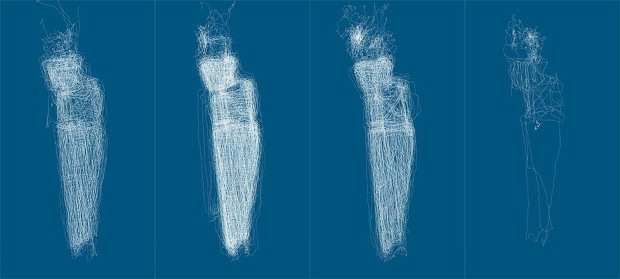 And here, he's cutting the grass over several months in the fall: 
Was he doing doughnuts in this one?  Work from his lawn-mowing adventures is on display at the Tenderpixel gallery in London until tomorrow. [youtube Fwlr16kLqHo] Wood is an American-born artist who works in the U.K. and Greece. He has built his career on "treating himself as a geodesic pencil," as the gallery's Web site says. He has mapped his own Ryanair flights around Europe, producing the world's largest pentagram (below). He has drawn a cat by traveling around Edmunds Park, in Oxfordshire, and has penned a giant Moby Dick quote in London by passing over a golf course, a parking lot, and a cemetery, among other sites, both public and private. Apparently he records all his daily journeys via GPS, which must make him more self-revelatory than Anaïs Nin. Check out his many awesome mapping projects at www.gpsdrawing.com. 
[Via Rhizome Inclusive; images courtesy of Jeremy Wood] 

 | | |
| Why 3D Is Better When It's In the Palm of Your Hand
June 21, 2010 at 10:38 PM
|
|  
We tend to think of 3D as being a large display affair--movie screens, or more recently, widescreen televisions. But last week Nintendo revealed the 3DS at E3. This next-generation handheld gaming device will feature a 3.53" 3D display that does not require the use of viewing glasses. At first glance, handheld devices might seem inferior for displaying 3D visuals compared their large-screen counterparts. But there are limitations to large, fixed displays that don't constrain handhelds. In fact, ergonomically speaking, smaller devices may be the superior platform for 3D content. For example, handled or mobile devices are intended to be viewed by a single person at a time, so the user can position the screen for optimal viewing. This isn't feasible when there a lot of people at various positions around a TV--they can't all be in the "sweet spot." Similarly, the most effective interaction with 3D content may be by having the display accessible at one's fingertips. Keep in mind that small devices are indeed mobile, not just in their portability, but in their maneuverability. A viewer can change the orientation of the device as a means of navigating 3D imagery and viewing it from different angles and perspectives, even putting the device down and moving around it 360 degrees. A natural fit for 3D handheld applications would be augmented reality applications that superimpose location-specific information on real-world visual scenes. 3D arguably provides greater benefits on a smaller display device because it is a means to get beyond the limited real estate of the screen. Instead of the horizontal and vertical screen dimensions, thoughtfully designed interfaces could allow users to navigate and review information in layers. But herein lies the challenge of the small screen--the ability to expand into an entirely new visual dimension brings with it a whole new dimension of poor design and information overload. Designers who have mastered information architecture in two dimensions will now need to expand their vocabulary to the third (3D banner ads anyone?). This may seem like a natural step, after all, we navigate everyday in the 3D world. But as with the design of gestural and natural interfaces, we must sufficiently understand human perception and behavior to make best use of these exciting technologies. Rob Tannen's Designing for Humans blog Browse blogs by more Expert Designers Rob Tannen is an expert in designing products, interfaces and systems that accommodate the complexities of human behavior and capabilities. He has researched cockpit interfaces for U.S. Air Force, designed trading floor order systems for the New York Stock Exchange, and created touch screen applications for consumer appliances. Rob is Director of User Research and Interaction Design at the product development firm Bresslergroup. He also has a PhD in human factors and is a Certified Professional Ergonomist. 

 | | |
| Online Privacy: What If Your Valuable, Personal Online Data Got Old and Died?
June 22, 2010 at 2:01 AM
|
|  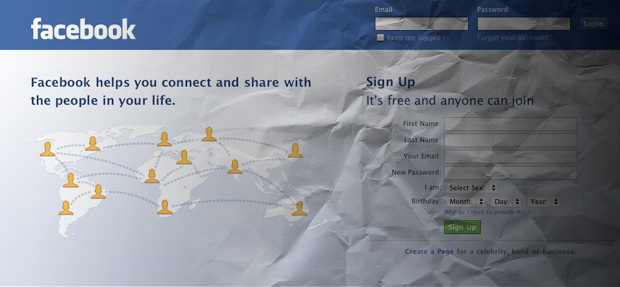
Online privacy is a hot potato. VC notables Venrock, Kleiner Perkins, and Accel Partners are all betting big bucks on privacy startups. "Privacy is a big issue, and it's going to get bigger because people realize it can be used against you. That spells market opportunity," says Ted Schlein of Kleiner Perkins. Meanwhile, the government is preparing to update existing legislation that protects individuals' personal data further, meaning someone's going to get burned. We're looking at you, Facebook and Google. But what if the question weren't whether to completely allow or block certain private information but how to make it fade away over time? Dutch student Harold van Heerde, of Twente University's Center for Telematics and Information Technology has a proposal to increase a person's privacy on the Internet, using software that automatically "fades" information after a certain amount of time. Van Heerde told FastCompany that, although "traditional databases have not been designed to remove data in such a way that it gives guarantees that data has been indeed irreversibly removed, we developed a prototype showing that it is feasible to implement the techniques." Would Facebook submit to such a system? And what about its 500 million or so users? "Facebook messages are only relevant from a user's point of view for a relatively short amount of time. How many users will search or look for messages a friend posted months ago? For Facebook, this data is much more relevant, since they can build profiles of their users to make money out of it. So Facebook will be very afraid that they might lose their business if this data will be destroyed." It's not so bad for Facebook, however, says van Heerde. "Degraded data can still be valuable, but less privacy sensitive. They [will have to prove] that it is necessary for the business to retain data endlessly. Otherwise, if old data doesn't contribute much to their business, they should take the risk into account of data disclosure and balance this risk with their interest." There are some places where an automatic lifespan wouldn't work--medical records, for example--but we're thinking more of those photos you posted on your Facebook Wall of your New Orleans Mardi Gras trip or the shots of you on Google Image performing in "Destiny," your 11th grade jazz choir. No one would expect the harvesters of personal data to jump on this--it's more like an idea for legislators looking for ways to balance the privacy issue with fair but effective law. While Facebook is definitely a believer in openness on the Internet, last month it had to make its privacy settings simpler, despite its CEO's disdain for the concept. Mark Zuckerberg, at Facebook's European Developer Conference was facing an increasing barrage of complaints from politicans and Internet users alike. Google's Street View technology, meanwhile, is hitting the headlines again today for all the wrong reasons, as French data protection agency CNIL has discovered that people's email passwords were hoovered up as the search engine giant logged Wi-Fi hotspots as it developed location-based services. Head of the FCC's Consumer and Governmental Affairs Bureau, Joel Gurin, wrote on the FCC's blog: "Whether intentional or not, collecting information sent over Wi-Fi clearly infringes on consumer privacy." Homeland Security Secretary Janet Napolitano is well aware of the problem and believes that if the U.S. is to be safer, it will have to wave goodbye to some of its civil liberties. "The First Amendment protects radical opinions, but we need the legal tools to do things like monitor the recruitment of terrorists via the Internet," she said in a speech last week. In other words, collecting data to ward off potential acts of terrorism and harvesting everyone's personal data--be it wittingly or unwittingly--are, two sides of the same coin. Which makes the case for a lifespan rather than a total blockage of personal data stronger. On the user side of the equation, van Heerde, for one, reckons, "A major privacy incident has to happen before people realize that they have something to hide. People do want to share what they are doing right now with the world, not what they did five years ago, and certainly not to an unauthorized audience." 

 | | |
| Voices From E3: Gaming Luminaries on Games as Art and Roger Ebert
June 22, 2010 at 1:55 AM
|
|  Back in April, film critic Roger Ebert stirred up a tempest in a teacup with his comment that gaming can never be art. Last week at E3, the game industry's annual mega-convention, I asked all the gaming execs and creators I interviewed their thoughts on Ebert's opinion and if they could give him one game to change his mind, what would that be. Their thoughts below. Laurent Detoc, North America president, Ubisoft:  Even Hideo Kojima [creator of the critically-acclaimed series Metal Gear Solid] doesn't even consider that video games are art, if I recall correctly. As a consumer, I don't actually like to look at if it is an art form or not. I think there is an ample case for explaining why it should be. Ebert has his opinion, and so do another billion people. I like to look at games as a set of experiences. Would I call that art? As a consumer, I don't think it matters. Even Hideo Kojima [creator of the critically-acclaimed series Metal Gear Solid] doesn't even consider that video games are art, if I recall correctly. As a consumer, I don't actually like to look at if it is an art form or not. I think there is an ample case for explaining why it should be. Ebert has his opinion, and so do another billion people. I like to look at games as a set of experiences. Would I call that art? As a consumer, I don't think it matters.
In my opinion, I think it is art. Because it is an artistic expression of one or more people who want to transmit their view. That would be my definition of art, and maybe if you look in the dictionary and it may something else. As for one game, I think every game is artistic. Based on what I am saying, it is the artists' representation of what they want you to experience. Either everything is art or none of them are art. Marc Whitten, General Manager of Xbox Live, Microsoft 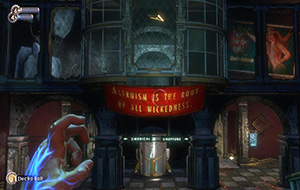 There's lots that fit into that. When you played through Bioshock the first time, the visuals were great and the story was amazing. When you played through and landed on the beach in the original Halo, it was a really special moment. When you play a lot of the games that we have on Xbox Live Arcade, the smile that comes to your face because you solve a cool physics puzzle or whatever, I think it is also art. It is for sure art to me--but then again, I love a lot of games. Geometry Wars I love, which I think is beautiful, and zen-like and having a great experience. Art is not one of those things that you want to put a box around. There's lots that fit into that. When you played through Bioshock the first time, the visuals were great and the story was amazing. When you played through and landed on the beach in the original Halo, it was a really special moment. When you play a lot of the games that we have on Xbox Live Arcade, the smile that comes to your face because you solve a cool physics puzzle or whatever, I think it is also art. It is for sure art to me--but then again, I love a lot of games. Geometry Wars I love, which I think is beautiful, and zen-like and having a great experience. Art is not one of those things that you want to put a box around.
Reggie Fils-Aime, President and CEO, Nintendo of America  Inherent in your question is part of what your industry needs to understand: Like any form of art, whether it's movies, whether it's books, whether it's television, the fact is, we don't have the same taste. And so there is a wide variety of option of every single taste. I can point someone to Super Mario Galaxy 2, which visually is a stunning game, easily approachable, something you would want to play with your kids. For some consumers that's great. There are other consumers, where their tastes will drive them to a product more like Halo. As an industry we have something for everyone. Which is, I would argue, one of the core fundamentals of an artistically-driven enterprise. Inherent in your question is part of what your industry needs to understand: Like any form of art, whether it's movies, whether it's books, whether it's television, the fact is, we don't have the same taste. And so there is a wide variety of option of every single taste. I can point someone to Super Mario Galaxy 2, which visually is a stunning game, easily approachable, something you would want to play with your kids. For some consumers that's great. There are other consumers, where their tastes will drive them to a product more like Halo. As an industry we have something for everyone. Which is, I would argue, one of the core fundamentals of an artistically-driven enterprise.
Joseph Olin, President, Academy of Interactive Arts & Sciences  I honestly thought that he might respond to Flower or Flow in some way, based upon his much publicized remarks--but he obviously did not pick up a game pad and play; basing his argument on Kellee Santiago's presentation from a TedX conference. I would have to say that Clover Studio's Okami would be my suggestion (although many arguments could be made for Metal Gear Solid 3). Okami was Hideki Kamiya's game based upon classical Japanese history (somewhat filtered) whose story was about Ameratsu, the sun goddess embodied as a white wolf and Issun, a self absorbed artist who ultimately forge a deep relationship while trying to restore life and color to black and barren land that was cursed by 8-headed dragon Orochi. The play mechanic, the 13 Celestial Brush techniques are the player's connection within this special world. It is a cerebral experience, not too challenging with its game play--and on the version for Nintendo's Wii--truly captivating on nearly every level. It is a game to be as much enjoyed today as it was in 2006. I honestly thought that he might respond to Flower or Flow in some way, based upon his much publicized remarks--but he obviously did not pick up a game pad and play; basing his argument on Kellee Santiago's presentation from a TedX conference. I would have to say that Clover Studio's Okami would be my suggestion (although many arguments could be made for Metal Gear Solid 3). Okami was Hideki Kamiya's game based upon classical Japanese history (somewhat filtered) whose story was about Ameratsu, the sun goddess embodied as a white wolf and Issun, a self absorbed artist who ultimately forge a deep relationship while trying to restore life and color to black and barren land that was cursed by 8-headed dragon Orochi. The play mechanic, the 13 Celestial Brush techniques are the player's connection within this special world. It is a cerebral experience, not too challenging with its game play--and on the version for Nintendo's Wii--truly captivating on nearly every level. It is a game to be as much enjoyed today as it was in 2006.
Sadly, I believe that it is impossible to have a discussion with Mr. Ebert about how game makers continue to create artistic experiences. He is not interested and as such truly does not wish to engage in a serious discussion because he will not try to play. I believe our medium will show more of the emotion of the experience with each passing year and that we can find other critics, who as champions of ALL artistic efforts--will be pleasantly surprised with the state of interactive arts today. Nick Earl, Senior VP and Group GM, Electronic Arts  I think Uncharted 2 is one of the most incredible, flawless entertainment experiences that I have played in my entire career. If he played that game, he would be able to get through it as a non-gamer, because you can't help but get through it. It is just so beautifully delivered--the dialogue, the story, the acting is world class. It will match up against any movie, in my opinion. I give them tremendous credit for what they did in that game. To me that is a beacon of hope for the industry, especially my group. I think it is art. It is absolutely art. You may have different opinions along the way, in the end you can't argue that is a wonderful experience that makes you feel so emotionally connected--I think that's what art is all about. I can tell you we have such aspirations here to match that quality. I think we are not going to rest until we match that in every franchise. I think Uncharted 2 is one of the most incredible, flawless entertainment experiences that I have played in my entire career. If he played that game, he would be able to get through it as a non-gamer, because you can't help but get through it. It is just so beautifully delivered--the dialogue, the story, the acting is world class. It will match up against any movie, in my opinion. I give them tremendous credit for what they did in that game. To me that is a beacon of hope for the industry, especially my group. I think it is art. It is absolutely art. You may have different opinions along the way, in the end you can't argue that is a wonderful experience that makes you feel so emotionally connected--I think that's what art is all about. I can tell you we have such aspirations here to match that quality. I think we are not going to rest until we match that in every franchise.
It's not just Uncharted. We are seeing a very strong macro-trend towards epic moments inside of a game. Call of Duty does it very effectively in their games. You feel like you are part of something absolutely magnificent. And it doesn't require you doing a 17-button combo to pull that off. There are magnificent moments in Street Fighter when it was in the arcade, but you had to hit six buttons to do it. What we're learning is that if you go out to a broader audience you have to be able to deliver something magnificent regardless of your skill as a gamer. Susan Panico, Senior Director of PlayStation Network, Sony  I am having a hard time picking just one. I think every game is a piece of art. Every game starts with an empty canvas that the game creator gets to paint his vision or her vision on and build something that is spawned from their imagination. If you really want to go to truly appreciating art, look at something like Flower. That created a new genre all together. It was beautiful to look at and presented a totally different, visceral experience than people were used to seeing in games. Little Big Planet, you can argue that is everybody's art, because everybody gets to create some type of expression of themselves. I am having a hard time picking just one. I think every game is a piece of art. Every game starts with an empty canvas that the game creator gets to paint his vision or her vision on and build something that is spawned from their imagination. If you really want to go to truly appreciating art, look at something like Flower. That created a new genre all together. It was beautiful to look at and presented a totally different, visceral experience than people were used to seeing in games. Little Big Planet, you can argue that is everybody's art, because everybody gets to create some type of expression of themselves.
I'm a little biased when I talk about Gran Turismo, because I used to working in the marketing department and I worked with Kazunori since the original GT. They go out with a microphone and put it up to the exhaust of an engine at every RPM rev of that particular car and do it for whatever hundreds of cars in that game. To have that level of passion, so you can express your product in such a realistic way. To me that is also art, or look at how the physics of that car perform or the reflections on the car. So I think in so many ways every video game is a piece of art in its own right. Ben Feder, CEO, Take-Two Interactive  It's hard for me to pick one game, because I love all my children equally. Some of our games are really product, but some of the higher end games--just show him one. Show him Borderlands, show him Red Dead Redemption, show him Grand Theft Auto 4. These are beautifully set, cinematic games with character development, storyline development, beautiful setting. Red Dead is such an awesome setting; you just fall in love with it. I don't know how these games can be anything but art, and an expression of art. I am personally gratified to be in business with guys that can create that, that have that talent and that foresight and that vision to create beautiful works of art. It's hard for me to pick one game, because I love all my children equally. Some of our games are really product, but some of the higher end games--just show him one. Show him Borderlands, show him Red Dead Redemption, show him Grand Theft Auto 4. These are beautifully set, cinematic games with character development, storyline development, beautiful setting. Red Dead is such an awesome setting; you just fall in love with it. I don't know how these games can be anything but art, and an expression of art. I am personally gratified to be in business with guys that can create that, that have that talent and that foresight and that vision to create beautiful works of art.
Stay tuned for more interviews from E3. 

 | | |
| EADS Debuts World's First Four-Engine All-Electric Aerobatic Plane
June 22, 2010 at 1:50 AM
|
| 
We know what you're thinking, those Red Bull Air Races are so cool, but do they have to be such gas-sucking spectacles? No. Enter Cri-Cri, the world's first four-engined all-electric aerobatic plane. Developed by the European Aeronautic Defence and Space Company (EADS), the plane made its debut at this week's Green Aviation Show in Le Bourget, France. EADS' plane has some impressive stats: 30 minutes of autonomous cruise flight at 68 miles per hour, 15 minutes of autonomous aerobatics at speeds reaching up to 155 miles per hour, and a climb rate of about 17 feet per second. The plane also features four brushless electric motors with counter-rotating propellers along with high energy density lithium batteries. In order to compensate for the batteries' extra weight, the aircraft uses lightweight composite airframe materials. EADS has big plans sustainable aircraft outside of the aerobatics world. The company recently unveiled a full-scale mockup of a diesel-electric hybrid helicopter, and earlier this month, EADS debuted the first ever algae biofuel-powered plane. The company has also teamed up with Eurocopter and BioCombustibles del Chubut on algae biofuel research. We're betting (and hoping) that EADS' algae research yields some concrete results for the commercial aviation world in the near future. Ariel Schwartz can be reached on Twitter or by email. 

 |  | | |
| Brother Can You Spare a Blender? The Scoop on Peer-to-Peer Equipment Rentals
June 22, 2010 at 1:34 AM
|
|  
With all the lawn mowers, table saws, and complete collections of CSI DVDs sitting around gathering dust in the shadowy corners of our homes, you would think the idea to rent out unused stuff would have come sooner. Especially as we inch our way out of the recession with the mantra, "frugality is the new black!" But while renting cars, bikes, films, etc. -- otherwise known as a "product service system" -- is big business for the Netflix and Enterprises of the world, loaning our bikes and bread machines to strangers is worrisome to anyone who's ever let a neighbor borrow a monkeywrench only to wonder where it went a year later. Fortunately, the idea behond Rentalic.com goes way beyond Mr. Bentley's earnest transactions with the Jeffersons. "The whole idea is to build a community-based rental market place where individuals or businesses in a community can share goods and services by renting to/from each other," says Punsri Abeywickrema, founder of Rentalic.com. With proper rental agreements and fees taking the place of a handshake and crossed fingers, the sites allow owners to make a little extra cash, and renters to save a bundle on stuff they'd only use once. Not to mention removing the unpleasant awkwardness of running into the borrower who still hasn't returned your stuff. Here are a few of the growing number of peer-to-peer rental sites Fast Company reviewed: Rentalic
How it started: Punsri Abeywickrema needed a wheelbarrow to work in his San Mateo, CA backyard. He'd already borrowed his neighbor's the weekend before and he didn't have room to store one of his own. Not willing to ask the favor again, Abeywickrema instead masterminded a site that would sponsor more professional transactions. How it works: Similar to eBay, individuals and businesses can setup a rental store and start renting. Rentalic also helps existing brick-and-mortar retail businesses hit by the downturn to tweak their business model and develop a rental businesses. Registration is free for owners and renters. The owner will be charged 5% of the total rental fee upon making a successful transaction. And there's a security deposit involved, you know, just in case the item gets trashed while it's being used. What's for rent: A small sampling includes a Dyson mini vacuum cleaner (rental $10 per week, MSRP $250), C++ for Dummies book ($5 per month, MSRP $30), audio engineering services (sound design and recording studio for $150 per week). Why it's secure: Like eBay, Rentalic uses a rating system. At the end of the transaction owner gives feedback to borrower and borrower gives feedback to both owner and the item. This feedback mechanism aims to filter offenders out of the system. PayPal takes care of secure payments. What about weirdos: Abeywickrema says weirdos and scammers are weeded out through a mobile secret code validation and payment processing system which allows the parties to do the validation and transaction processing from any remote location by dialing in an 800 number. That, and counting on users being smart enough not to have strangers come borrow or pick up at their homes. Zilok 
How it started: Two friends in France needed a drill to hang something. Buying didn't make sense when they figured out a drill is only used for about 12 minutes the entire time it is owned. Says Jeff Boudier, co-founder and potential drill renter, "The old paradigm of buy and use it once and store it forever is shifting to an economy based on usage and accessibility." How it works: Zilok allows both individuals and professionals to rent. Once a rental is established, Zilok generates a contract and issues contact information for the borrower via email or text message. Owners keep a security deposit until the item is returned. When the transaction is complete, Zilok has a rating system for the whole experience. Registration is free for anyone, however, owners pay a retainer fee which is a commission on the transaction. What's for rent: Loads of stuff including, a two man inflatable raft ($29 per day), a Toyota pick-up truck ($80 for a weekend, Enterprise rental is sold out but an SUV in the same area is $150 per day). Why it's secure: Zilok is counting on the honor (and common sense of its users). What about weirdos: General policies and advice are listed on the site and the evaluation method is there to ensure everyone plays nice. The page that is supposed to list procedures for car insurance is incomplete, though. Rent-Instead 
How it works: Rent-Instead offers free listings and options beyond rental, allowing customers to try before they buy, including the ability to purchase or rent-to-own items. It supports several delivery options from shipping, to owner delivery and pickup, renter pick up and return. Regarding fees, Rent-Instead tells us, "We do charge fees for using other services, such as renting items. When you rent an item or use a service that has a fee you have an opportunity to review and accept the fees that you will be charged based on our Fees schedule, which we may change from time to time." What's for rent: Anything from cars to real estate to tools and sundries such as a "Sexy Schoolgirl" costume ($10 per day, underpants and necktie not included) and a shower chair ($1 per day, soap not included). Why it's secure: Rent-Instead uses AlertPay which is FDIC and CDIC insured through the U.S. and Canada. Credit card and bank info are encrypted as with PayPal. What about weirdos: Contact information is hidden if the renter or owner prefers. In addition, Rent-Instead advises, "Always communicate with Owners through Ask Owner a Question. This is the most secure means of communication. When you use this, copies of the emails will be sent to My Messages, and you have the option of hiding your email address from the Owner." 

 | | |
| Inflatable Buildings That Could Earn $10 Million a Year
June 21, 2010 at 11:29 PM
|
|  Using clever, super-green construction methods, Woods Bagot proposes a building system that would make use of the stalled sites littering New York. 
In New York, the most glaring signs of the Great Recession are the stalled construction sites littering the city--boarded up, dusty, and desolate eyesores. The architecture mega-firm Woods Bagot may have a solution, which they've just unveiled: Temporary, inflatable buildings that let the developers make money while they wait for their finances to shape up. "We tried to re-imagine how you could reuse those sites," Jeff Holmes, the partner in charge of Woods Bagot's New York office, told FastCompany.com. "But it had to be a real proposal. There's been a number of creative solutions in New York and Boston because of the number of stalled states. We took a hard nosed look at creating something viable." Stalled sites pose a problem for developers whose financing has dried up in the recession because even when sites lay unused, they wrack up huge tax burdens--as much as $2 million a year. And sites can easily go fallow for 2-5 years. 
[Above: The stalled sites around New York] The obvious solution is a "tax payer building": A temporary structure that lets the developers collect rent money. But all to often, these have been a disaster. For example, New York's Lexington Avenue is littered with ugly temporary buildings, erected decades ago, which never were demolished or rethought. "The biggest challenge is creating a quality scheme that can go in quickly, and be taken away even quicker," says Holmes. Moreover, it's hard for a temporary building to have a big, good-looking presence on the street--rather than being just a glorified drywall tent.  Holmes's team solved the problem with what they call an Iceberg. Made of modular units that can be added up for larger sites, the design calls for a steel structure wrapped in high-tech plastic fabric called EFTE (which was used most famously in the Beijing Water Cube and the gorgeous Allianz Arena). But that fabric also has "air beams" stitched into it--structural supports that are basically big balloons, and are usually found in high-end pup tents and airplane evacuation ramps. As a result, when inflated, the EFTE becomes a dramatic, faceted roof that turns the temporary building into big, dramatic piece of contemporary architecture. "The volume is almost nothing but air," says Holmes. "Which means there's a minimal carbon footprint."   Every inch of the structure can be disassembled in a week, from the plastic to the steel to the temporary concrete slab. What's more, Holmes and Woods Bagot believe that simple economics make the Icebergs into a win-win solution for developers. Given construction costs of about $2 million, they estimate that an Iceberg could bring in at least $1 in rent in the first year, and $2 million after that. (They figured a rental rate of $450 a square foot; Manhattan retail spaces rent for between $250-2500.) Moreover, because of the huge faceted planes on the Iceberg facade, they can become huge projection screens, drawing advertising revenues. (Although Holmes is at pains to point out that they would want to do this respectfully.) According to Holmes, if placed in prime stalled locations, such as 440 Park Avenue at the old Drake building, an Iceberg could easily generate $10 million a year.  Currently, Holmes and his team are shopping the idea around to developers, having already opened up a number of "informal" conversations. Given the economic predictions of a soft recovery, and the ongoing, moribund state of real-estate financing, you might see these coming soon. 

 | | |
| Blue "Lightsaber" Laser Can Burn Flesh, Permanently Blind and Costs Only $200
June 21, 2010 at 11:28 PM
|
|  
That little hunk of frost-coated hardware in the photo is the Spyder III Pro Arctic blue handheld laser. It's being marketed as the closest thing to real-life Star Wars lightsaber ever. Because this $200 piece of Chinese gear can fry your retinas. The product's sales spiel is pretty no-nonsense: "For the first time in history, direct blue laser diodes have now become available in the consumer market. The laser powered home theater projector is the first of a large family of audio and video media technology to feature direct blue diodes. Wicked Lasers took the direct blue laser diode components and made the world's first 445nm direct blue diode laser, the Arctic." Fascinating. And for those scientists among you it'll be doubly interesting, as the race to make cheap portable direct blue lasers has been long and hugely complicated--the physics of them has always seemed to be frustrating. Blue lasers are what make Blu-ray players work, and they're important because the shorter wavelength of the blue light versus red or infra-red lasers means you can focus the laser to a smaller spot: This gives Blu-rays their much higher data density than DVDs or CDs. 
In the case of the Spyder III, the blue light is more of a fun sales pitch-- emphasizing the cool, blue light instead of garden-variety red or even the increasingly common green lasers on the market. The question, of course, is, what exactly will be the Spyder's targets? If you're talking about putting a spot on screen during a Powerpoint presentation, you'd probably be able to do that with the Spyder from the next country over. The device is touted as being "4000% brighter than the Sonar's 405nm violet beam" and while this is a tad misleading, since the wavelength and brightness aren't tied, what is important is how intense the Spyder actually is. It's a Class iV laser product, which means it technically needs to be slapped with a yellow warning label that reads "Laser radiation. Avoid eye or skin exposure to direct or scattered radiation." I used to use a desktop Class IV laser for experiments, and after seeing some laser injuries I was petrified of the thing--they can burn your skin and bind you by scarring your retina really easily, in some cases by indirect reflections off a matt surface. And for those of you who remember the spate of laser dazzling incidents, with people firing them into the cockpits of airliners on final approach to airports (one was in the news as recently as April, with a guy trying to distract the pilot of a police helicopter) your level of worry will now certainly be elevated: Those lasers could merely dangerously dazzle pilots for a brief instance, these could blind. Permanently. Oh, and if you need some more pointers on what this laser can be used for, check out the promotional video: [youtube MzsNGiV1YXU]  To keep up with this news follow me, Kit Eaton, on Twitter. That QR code on the left will take your smartphone to my Twitter feed too. To keep up with this news follow me, Kit Eaton, on Twitter. That QR code on the left will take your smartphone to my Twitter feed too.


 | | |
| Infographic of the Day: The World's Most Dysfunctional Countries, Ranked
June 21, 2010 at 11:03 PM
|
| Yay! Afghanistan and Iraq made it! Oh, right: You don't want to top this list. 
Foreign Policy magazine is up with its 2010 Failed State Index, a massive project that tries to figure out what countries are on the verge of total collapse thanks to corruption, war, crime, and everything in between. This year, they've supplemented their findings with a handy dandy infographic. Somalia, with a score of 114.3 out of 120, comes out on top, with Aghanistan, Iraq, and Pakistan close behind. That score represents the combined results along 12 different metrics, ranging from the presence of a vengeance-seeking group to human-rights violations to the rise of factionalized elites. And while those seem like squishy qualities, FP, working with The Fund for Peace actually figured out a way to make them quantitative, by using computers to comb through hundreds of thousands of news articles on each country. That showed how frequently problems of each sort were mentioned in articles about that country. 

 |  | | |
| $149 Nook: The E-Reader's Demise Begins With a Race to the Bottom
June 21, 2010 at 10:43 PM
|
|  
Barnes & Noble has just revealed its Wi-Fi-only Nook, the first serious attempt at undercutting Amazon's Kindle e-reader business with a store and hardware combo. But it's more than that: It's a sign of the changing e-reader game. The Nook Wi-Fi is basically the same as the original 3G-enabled Nook e-reader, with all the expensive 3G wireless tech taken out. Think of it as the Nook equivalent to the Wi-Fi-only iPad--and just as with Apple's machines, the simpler device costs less as there's less hardware inside. The clever thing B&N has done is to pin the price point of the Wi-Fi-only Nook at just $149. That's a truly magical price, and since the device comes with the huge B&N e-bookstore ecosystem behind it, and has that funky color touchscreen aboard it'll no doubt attract many a shopper who'd been previously shy of buying an e-reader through cost implications--or not wanting to buy a totally new class of device from a cheap but unheard-of provider. The limitations of only being able to download new books or use the Nook's Web powers only when in range of a wireless network won't really be an issue for many folk just looking to buy their first digital book reader, particularly at that attractive price. But B&N have done more than this--the price of the original 3G-powered Nook has also been dropped to just $199, making it the "first under-$200 dedicated full-featured e-book reader that offers both free 3G wireless and Wi-Fi connectivity" according to B&N's press release. It's potent stuff, and it makes Amazon's Kindle 2, with no color screen and an aging-looking design look like even more of an expensive dinosaur at $259. B&N are, of course, trying to leverage cheaper hardware sales to lure potential buyers away from the glitzy but more expensive Apple iPad, and the booksellers are also really trying to push their hardware so that the users will then buy more e-books from B&N rather than any other e-retailer--like Amazon. Yet the move is also symbolic of the e-reader's only true option in the changing mobile-device market: The beginning of the race to the bottom. It's a parallel to the netbook phenomenon, which saw a cheap, low-powered reinvention of the notebook PC hit the market and attract buyers because of its cheap price and perceived hardware benefits (like a long battery life). The strategy worked at an incredible pace at first, because the prices were so ridiculous and seemed to be getting ever-cheaper. But then the average Joe became aware of the netbook's serious limitations, and its supposedly longer battery life suddenly seemed less attractive. Now the phenomenon is over, and the netbook is merely another class of computer to buy--at a lower price, with many fewer capabilities. This is how the e-reader market is likely to go too: The device's only real benefits are the e-ink screens, which are marketed as easier on the eye than tablet PC's LCD units, and longer battery life. Starting from this simple basis, the machines can hardly get smarter as they'll start to compete with full-on tablets, and the e-ink technology just can't deliver video or even simple gaming or web-browsing very well, so they'll just have to get cheaper and cheaper in order to attract users. Despite efforts by even the great Ray Kurzweil to beef up the way e-readers work (why is their pagination and font control so poor? why are the UIs insufferable?) the e-reader is, I think, doomed. This race to the bottom will work for a bit, and then the phenomenon will fizzle, and the e-reader will tag along as another mobile PC form factor, with a few specialist benefits which'll appeal to some users. Its place will be taken with the all-purpose tablet PC ... just as soon as folk realize there's more you can do with these, and that the LCD screen is absolutely fine for reading from.  To keep up with this news, follow me, Kit Eaton, on Twitter. That QR code on the left will take your smartphone to my Twitter feed too. To keep up with this news, follow me, Kit Eaton, on Twitter. That QR code on the left will take your smartphone to my Twitter feed too.


 | | |
| Michael Grätzel's Solar Cells Get Stylish With Color and Translucent Materials
June 21, 2010 at 10:08 PM
|
| 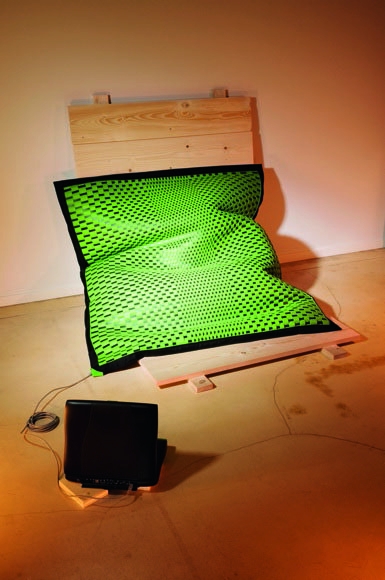
Michael Grätzel may be the closest thing to a living legend in the solar energy world. A professor at École Polytechnique Fédérale de Lausanne, the Swiss scientist discovered a new type of thin-film solar cell--dubbed the dye-sensitized solar cell (aka the Grätzel cell)--in 1991. Now, nearly two decades later, Grätzel's invention is taking off, with companies like Konarka, Hydrogen Solar, and Sony developing the cells for commercial use. Grätzel's cells, which are inspired by the photosynthetic process, consist of a porous layer of titanium dioxide nanoparticles covered with a sunlight-absorbing molecular dye. The cells currently have a lower efficiency than single crystal silicon cells, and Grätzel's technology offers a number of advantages. In a traditional silicon solar cell, the silicon acts as both a source of photoelectronics and an electric field. But in a dye-sensitized solar cell, the semiconductor is only used for transport, while the photoelectrons come from a separate photosensitive dye. As more research yields higher-efficiency Grätzel cells, companies need only switch out their dyes--the rest of the production process stays the same. Dye-sensitized solar cells have another distinct advantage: The dyes can be manufactured in an array of colors. The Sunny Memories project, featured earlier this month at New York's Center for Architecture, exploited this feature with colorful solar designs. Grätzel's cells can also be made translucent--a first in the solar industry. "In this respect they have a unique application, like for electric power-producing windows and glass facades," he says. Right now, though, dye-sensitized cells are mostly found on solar phone chargers and solar energy-producing bags--a product of the cells' ability to be printed out on flexible sheets.  According to Grätzel, the cells are getting more efficient all the time. "We are making good progress with developing more efficient sensitizers that harvest light in the infrared region," he explains. "This year we hope to get to 13%, the next to 14%, once we have 15% we will be very happy because this would put us on par with other technologies in direct sunlight conditions." Grätzel recently received the $1 million Millennium Technology Prize--an award that will help the scientist continue research on his cells. He says that most--if not all--of the money will be spent on his research, which includes a large laboratory and two small pilot lines that manufacture cells under controlled conditions. The forward-thinking scientist believes that his technology will ultimately filter into our daily lives. "I think we're going to have a lot of these cells penetrating our living space and being integrated in buildings. A further important application of our cells will be to provide electric power for portable electronic equipment and electric cars," he says. Grätzel can't possibly solve our energy crisis, but he's certainly giving us a boost. Ariel Schwartz can be reached on Twitter or by email. 

 |  | | |
| Wiring A Smart City In the Desert
June 21, 2010 at 10:03 PM
|
|  
Is Dubai the world's smartest city? Maybe not in the sense that it mortgaged long-term infrastructure with $100 billion in very short-term debt, but "smart" in a way IBM, Cisco and other tech heavyweights would be envious of. One advantage of building a city from scratch is that each of Dubai's 60,000 modern buildings is equipped with the state-of-the-art in lighting, HVAC, and security systems--all of which can be wired to the Internet. Last week at the Realcomm 2010 conference in Las Vegas, a Dubai software firm named Pacific Controls revealed it had beaten Cisco to the punch in creating the world's first "smart city" by connecting 20,000 of those buildings – including the world's largest mall and largest building – to a cloud-based platform capable of controlling each remotely. Using its software to track and fine-tune electricity usage in nearly half of these buildings (some 9,000 in all), Pacific Controls has managed to cut their power bills by 20% -- and is willing to do the same for any building in any city in the world. The company has succeeded in adapting software-as-a-service to offering cities-as-a-service in the form of "Galaxy," which uses Java-based middleware and the Internet to connect building systems to its data centers, which can be located anywhere in the world. (One is in its LEED Platinum-certified headquarters in Dubai; the other in downtown Manhattan.) IBM intends to wire Dubuque, Iowa in a similar manner – incorporating municipal utilities into its system – and in instant cities across Korea, China and Saudi Arabia. But Pacific Controls did it first, thanks in large part to a recent law decreed by Dubai's ruling Sheikh Mohammed bin Rashid al Maktoum that all buildings in Dubai be monitored remotely in case of fire or public safety hazard. CEO Dilip Rahulan explained to me that building owners have rushed to sign up for Galaxy to be in compliance with the law – in addition to the 20,000 buildings his firm now controls, he is busy adding 120 a day. Those include the Dubai Mall at the base of the Burj Khalifa (which isn't connected yet, but will be soon, he promises) and Dubai International Airport's new Terminal 3, in addition to more than one hundred government buildings and four hundred vehicles retrofitted with GPS. In the event of an emergency, Galaxy will not only send an alarm to Dubai's fire and police departments, but also track their arrival on the scene. Rahulan founded Pacific Controls in Dubai in 2001, when it was already apparent that "real estate would take off exponentially there," and also that "the Internet would be the backbone through which city services would someday be delivered." His engineers in India and Dubai spent three years building Galaxy atop software originally used for transmitting telemetry data from aircraft (such as the last cryptic messages from the doomed Air France Flight 447, which vanished over the Atlantic last summer). For now, Galaxy's use is limited to monitoring what he calls "the heartbeats of buildings," but Rahulan hopes it will expand to encompass municipal systems such as Dubai's power grids in his Quixotic quest to wring cost savings and lower energy use from the least sustainable city in the world. Perhaps Rahulan's most important insight, however, is that smart buildings and smart cities can be run from anywhere. For this reason, Pacific Controls has started looking farther afield for customers, starting with the campus of Saudi Arabia's new King Abdullah University of Science and Technology – the world's largest LEED Platinum project. The company has signed a deal with the Carrier Company to remotely control ten thousand of its commercial HVAC systems, and in the meantime is busy bringing buildings in China, the U.K. and U.S. online. The ability to expand in every direction at once is the reason the $100 million company is growing at a rate of sixty percent each year. Why stop there? While in Vegas last week to speak at the annual Realcomm conference (which started discussing smart building a decade before IBM found its "Smarter Planet" religion) Rahulan met with representatives of the General Services Administration – the landlord of 8,500 buildings owned by the U.S. government. Perhaps Galaxy will be coming soon to the federal courthouse near you. [Photo via Flickr/Christopher Walker] 

 | | |
| Blockbuster CEO Jim Keyes on Bankruptcy, Netflix, and Becoming the Next Apple
June 21, 2010 at 8:37 PM
|
|  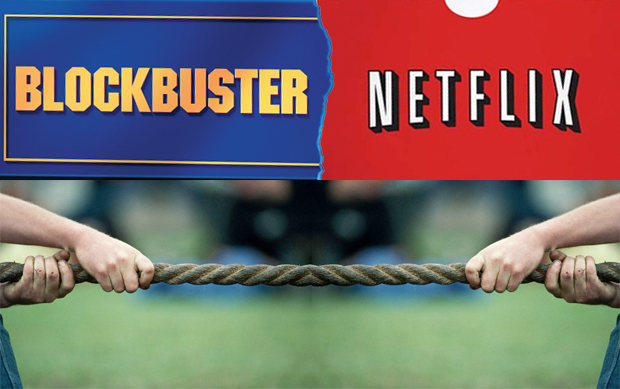
While it may feel like an all out tug-of-war between Blockbuster and Netflix, don't forget they aren't the only companies battling for market share. Redbox is fighting for kiosk space. Apple, Amazon, and Comcast are competing for movie download purchases. And Hulu will soon start its subscription-based service. Blockbuster is trying to fend off all these competitors, even as the company is mired in debt. We spoke again with the company's CEO, Jim Keyes, to get his take on Netflix's recent comments with Fast Company (Click here for our first interview with the the Blockbuster chief, in case you missed it). Keyes spoke with us about how he's using the company's 28-day distribution advantage to Blockbuster's favor; the ways he's trying to turn the video-rental giant around, Steve Jobs-style; and why bankruptcy isn't interfering with the company's plans for success. Fast Company: Blockbuster's 28-day distribution advantage gives the company a 4-week leg up on Netflix for new releases. However, when I spoke with a rep from Netflix, he said this was something they actually heavily pushed for years ago. Who went to the studios first? Blockbuster CEO Jim Keyes: We're both going to the studios all the time for different kinds of deals. I tried to emphasize before that our customer base is very different--our core focus is very different. Their focus is more on the longer-tail titles. Ours has traditionally been on new releases.  Why though, if this deal was so beneficial to Blockbuster, would Netflix have pushed for it so heavily? It's a different business model. Theirs is a subscription model that focuses more heavily on older titles. Blockbuster has a broader range offering. The majority of our business--as much as 80%--has been in new releases. Why though, if this deal was so beneficial to Blockbuster, would Netflix have pushed for it so heavily? It's a different business model. Theirs is a subscription model that focuses more heavily on older titles. Blockbuster has a broader range offering. The majority of our business--as much as 80%--has been in new releases.
Netflix has said that if customers "were really interested in a movie, they would've already seen it in the theater." Did Blockbuster do research before making this deal that showed otherwise? Our research says it's about a $20 billion business for rental and retail, and approximately more than 60% of business for new releases is done in the first 30 days. The bulk of the business has traditionally been in new releases. People want rushed content. Our job is to provide it for them. There is also a market for the longer-tail content, and Netflix has made that their focus. The trade off is one of economics. They were looking for a lower cost of goods, and were willing to accept a delay in the offering. For us, when Avatar is released, our customers want it that day, and we have it on a cross-channel basis. One industry source I spoke with suggested that Blockbuster had little control over the 28-day deal with movie studios, and ended up committing "huge payments" for new releases because of the company's financial position. Is this not the case?Our deals are very consistent with the economics of the past. We're pleased with the studios flexibility in allowing cross-channel availability--we're pleased with their continued support, and the ability to offer our customers what they want. You've explained that Blockbuster is in the process of remodeling, yet everyone I speak with describes it less positively. One industry source even suggested that you were "whistling by the graveyard."We're in the process of transformation. Think about Apple ten years ago. Steve Jobs came back and did a masterful job. But it wasn't an overnight success. It took him a number of years to reengineer Apple and turn the company from what it was--basically a PC provider--into what it is today. I don't know if you recall, but there were questions about the long-term viability of that company, and look at the success that they have today. But it took many years. But Steve Jobs returned, I believe, around 1997. By 1998, they released the iMac. What is the equivalent at Blockbuster? The equivalent for Blockbuster is Blockbuster On Demand, which is the ultimate video on-demand experience.  So you see Blockbuster as another Apple?I use that as an example. There are hundreds of examples of companies that are traditionally great brands, but had to transform themselves into a new business model. This is a pattern we see over and over. If a company is not able to keep up with the changing needs of its customer, it will become irrelevant. Our job is to keep pace with that change. So you see Blockbuster as another Apple?I use that as an example. There are hundreds of examples of companies that are traditionally great brands, but had to transform themselves into a new business model. This is a pattern we see over and over. If a company is not able to keep up with the changing needs of its customer, it will become irrelevant. Our job is to keep pace with that change.
With Blockbuster's multi-channel platform, do you ever worry that customers will just do what's most convenient? For instance, won't a customer always choose a Redbox kiosk if it is closer? Or just use Comcast or iTunes if it's easier? Or, if a Netflix subscriber notices Avatar is unavailable, can't he or she just rent it from Blockbuster that one time? It's unclear why a customer would need to commit to Blockbuster as a subscriber, kiosk user, and on-demand customer. What about the fickle customer who might just use Blockbuster for a new release every now and again? The advantage of cross-channel capability is all about convenience. In our case, if you receive a movie in the mail, and then watch it, you can go to the store and exchange it for, say, Alice in Wonderland--and you have immediate gratification. You don't have to wait for a queue. Very simply, we have more new movies than anyone else. If you're looking for a new release, you have a better chance of finding that at Blockbuster. If there is an alternative closer to you, but you know you'll only get a new release at Blockbuster, we hope you'll be willing to travel that extra distance. If you're looking for a new release, but you're not sure it's been released on one of our competitors's services or on iTunes, we hope that customers will choose Blockbuster On Demand. They will count on us for new releases. Across all these platforms--on demand, in-store, kiosks--you have one account that just makes it easy for you. It's that one customer, one account convenience. To create that convenience, Blockbuster has a kiosk system, subscription and on demand services, and in-store offerings. It almost feels like you're boxing an octopus: battling Netflix for subscribers, Redbox for kiosks, and Apple and Comcast for on-demand service. Do you ever feel like Blockbuster is stretching itself too thin? It's an incredibly dynamic industry that's changing very quickly. But we do not look at this as a sprint, we look at this as a marathon. We want to provide a better long-term platform for our customers to give them the most convenient access whether physical or digital form. It takes time and resources, but we believe the outcome will be a better consumer proposition. You've said remaking Blockbuster won't happen overnight--that it's a marathon. Do you ever worry that this is a situation where you need to remodel overnight, and that Blockbuster might not have time for a marathon? We are going to move at the fastest pace possible. The customer change doesn't happen overnight. If you look at the acceleration of paid digital consumption of content, it isn't moving as quickly as we would all like. We'd all like to have movies move more quickly to video on-demand. That consumer adoption is moving steady, but not as quickly as anyone would like. In the news lately, we've seen Blockbuster seeking $150 million debtor-in-possession financing. It's worth asking again: Is Blockbuster going bankrupt? We're transforming not just the business model but the balance sheet. We've had two successful refinancings in the last 18 months, and we continue to work on finding the right capital structure to facilitate the business itself. So Blockbuster is not going to file for bankruptcy protection? As I've said, we're looking at all of the various options to refinance and recapitalize the company. I've said repeatedly that the company's objective is to seek out-of-court solutions with strategic investors to recapitalize, and we've been exploring a number of those alternatives. If I look at Blockbuster's share, it's hovering around 30 cents; I've seen this $150 million debtor-in-possession loan recently; and I've also read that the company has around $900 million in debt. How do you convince an investor to stay with the company, and how do you bring in new investors? As I've said, we're in the process of an overall business transformation, and we are trying to accomplish that transformation in a way that provides the greatest return for all of our stakeholders. That's our objective. You recently told the Wall Street Journal that "this is not a time to sit on the sidelines for six months while the technology side of our business is dramatically changing daily." With Apple releasing its iPad, why hasn't Blockbuster created an app to rival Netflix's? Why wasn't Blockbuster on stage at WWDC, instead of Netflix, if you're trying to keep up with this rapidly changing technology? We have taken a bit of a different path in the near-term. Our more aggressive push has been for download applications rather than streaming for portability. The limitation of streaming in a portable device is that you have to be in a strong 3G area or a WiFi hotspot. It is somewhat inconsistent with the concept of portability. We believe in the download capability for Blockbuster On Demand into portable handsets like the HTC phone. We took a little bit longer to introduce an iPhone app, and we will have an iPad app as well. It's just a question of priority, timing, and resources. Can I get a sense of your feelings on the iPad and iPhone 4? I know Blockbuster's app is related to managing queues, but do you ever see a time when it could be used for movies? They're terrific devices. Now, if you think about the different business models of Netflix and Blockbuster, Blockbuster's model is more directly competitive with Apple in the sense that we are a transactional-based service, offering movies à la carte. Netflix's subscription-based service doesn't conflict with the iTunes offering. It doesn't mean we won't make content available, but you don't see Amazon movie downloads yet either.  I don't mean this in a sarcastic way at all, but have you had a chance to use Netflix's iPad app? It's very popular, and I just wonder why Blockbuster would be against that type of streaming offering? We're not against streaming. We have a terrific streaming service. I wish you'd try it. I don't mean this in a sarcastic way at all, but have you had a chance to use Netflix's iPad app? It's very popular, and I just wonder why Blockbuster would be against that type of streaming offering? We're not against streaming. We have a terrific streaming service. I wish you'd try it.


 | | |
| iFive: BP's Hayward Sails Into PR Storm, Facebook Movie Poster, World Cup Red Cards, Wimbledon Begins, Red Sea Redemption
June 21, 2010 at 8:09 PM
|
|  While you were sleeping, innovation was limbering up for a competitive game of tennis, lobbing balls over the net, rather than into the back of it. 1. So, Tony Hayward went sailing into yet another PR storm. Meanwhile, an oil worker on the Deepwater Horizon rig claims that the leak was identified before the explosion, and both BP and Transocean were notified. Details of the attempt to prevent the blowout are now emerging. 2. You've signed up to Facebook, got the friends, played Farmville, now see the poster of the movie. Jesse Eisenberg plays Mark Zuckerberg, who may or may not be facing the death penalty in Pakistan, in the Aaron Sorkin-penned The Social Network, and it's in movie theaters this October. Looking forward to Columbia Pictures' Facebook marketing campaign. 3. The red card given to Brazilian soccer star Kaka on Sunday night must be rescinded, says a Twitter user. Referee Stephane Lannoy could be the first casualty of the World Cup, for his substandard officiating of the Brazil-Ivory Coast match. However, what is a World Cup without a little bit of controversy? 4. Meanwhile, non-football sports fans may be pleased with the arrival of the Wimbledon tennis tournament, which begins today. NGO Oxfam will be cheering on Roger Federer who, if he wins an unprecedented seventh title, will net the charity £100,000. 4. While Israel is at last to ease its blockade of Gaza, allowing civilian goods in for the first time since 2005, there's a storm brewing in the Dead Sea. A plan to pump water into it from the Red Sea in order to stop its waters receding any more is coming up against heavy opposition from both the environmental lobby and the industrial sector. 

 | | |
| Microsoft's Kinect vs. Sony's PlayStation Move: Video Game Showdown
June 21, 2010 at 7:47 PM
|
|  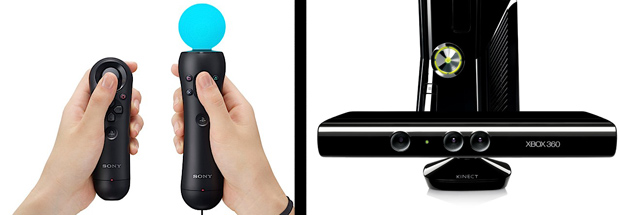
E3, the mega-conference where next year's video games are unveiled for the press, has concluded. Microsoft and Sony are both turning to Wii-like motion controllers as a way to extend the life of video game consoles, and each revealed new games and hardware. Now that the dust has settled from the showdown, which platform came out the winner from the game extravaganza? Sony's presentation hyped Move, a more precise and ergonomic version of the Wii-mote controls. On display was a mix was of "hardcore" genres (Socom, Sorcery), more mainstream (Tiger Woods), and casual titles (EyePet). Unfortunately, there just wasn't a wide enough assortment of games to fully demonstrate the power of the new technology. Microsoft on the other hand, went right for the mainstream with its motion-control system, Kinect. They showed off minigame titles (Kinect Adventures), fitness games (Your Shape), and casual experiences (Kinectimals). Kinect feels unique, unlike anything else on the market--even if it uses a camera similar to the PlayStation Eye. Your Shape really captures yoga and analyzes the angles of your limbs as you bend and stretch. And while there is a tiny delay in the games' reactions to your movement, good game design should effectively make up for it. In the end, it is a tie when it came to games: Sony's precision and mix of titles stood toe-to-toe against Microsoft's more casual, but unique approach. Ben Feder, CEO of game publisher Take-Two said, "Move is exciting for us because its really got a fine motor control that we can utilize, especially in basketball. Kinect is exciting because no controller required--the dance game they have out, the exercise games they have out, are awesome. From a third-party perspective, it's all complementary. It's not one versus the other--it's all opportunity for us." Electronic Arts, true to their roots as a platform agnostic publisher, dipped its toe into both systems, with Tiger Woods for Move and EA Sports Active for Kinect. But an informal survey of games being demonstrated by third-party publishers, indicated there are many more Kinect games in development. From Konami (Dance Masters, Adrenalin Misfits), to Sega (Sonic AirRiders), to WB (Game Party in Motion), to Ubisoft (Your Shape, Sports Motion) all seemed to favor Microsoft's technology. Perhaps Kinect's interface wins publishers' hearts. As I controlled the Xbox through gestures and voice, it felt like the future. And video chat in the living room could be a game changer. I believe Microsoft is edging out Sony so far. Of course, without a confirmed price for Kinect, a possibly high price may shift interest. Of course, E3 wasn't just about motion controls. Sony's embrace of gaming on 3-D televisions (Killzone and Gran Turismo) was a step forward for the industry. And despite the wealth of great games on offer, the game industry gets particularly revved-up over new hardware, in which case maybe both companies lost out entirely to the Nintendo 3DS. 

 | | |
| Toshiba's Trio of New Laptops Includes A Dual-Screen, Windows 7 Oddball
June 21, 2010 at 4:33 PM
|
|  
Toshiba announced three new laptops today, two of which are slightly unusual and one of which is completely bonkers. The most normal is the Portege R700, an ultraportable with some legitimate power. The R700 is business-focused (hence the drab, ThinkPad-like design), but with a full Intel Core processor and a mere inch of thickness, it's a pretty impressive bit of hardware (it shoots air over certain internal components to stay cool). At less than three pounds, it's about as light as a MacBook Air, but has a DVD drive, unlike the Air. It's fairly cheap as well, starting at $900, and is available now--could be a nice alternative to the ThinkPad. 
The AC100 is Toshiba's first netbook running Google's mobile Android OS (usually seen on smartphones), and really one of the first Android netbooks to be made by a major company. It runs on an Nvidia Tegra chip (the same one in some smartphones and PMPs), and despite being only 14mm thick, it's supposed to run for up to eight hours on a single charge. The oddest part? The AC100's 10.1-inch screen doesn't seem to be touch-enabled. That'd be like controlling your iPad with a trackpad and keyboard--doable, but distinctly unnatural. It'll be available in August for an unspecified price. Now for the weirdo, the Libretto W100. Toshiba calls it an "ultra-mobile PC," which strikes me as a dangerous term, seeing as how it refers to a segment that steadfastly refused to take off here in the States. It's in the shape of a traditional, albeit tiny, hinged laptop, but with two 7-inch multitouch touchscreens. It's got somewhat respectable internals, for such a device, with a 1.2GHz Intel Pentium U5400 processor, 2GB of memory, and, oddly, a 62GB SSD for storage. So how does this thing work? The Libretto W100 runs Windows 7, and you can choose to use both screens individually or together (as an extended screen). That bottom screen has a few unique uses put together by Toshiba--it has a whopping six different keyboard options (including a split-keyboard for thumb typing, which seemed to go over well with those who played with it) as well as Toshiba's custom bulletin board UI (pictured top). The Libretto W100 may look like a crazy concept, and it sort of is, but Toshiba's actually bringing the thing to market "in a few months." It'll cost $1,100 when it comes out, though it'll be a limited run "for early adopters." Those are usually code phrases for "it may not work very well," but we'll reserve judgment. Dan Nosowitz, the author of this post, can be followed on Twitter, corresponded with via email, and stalked in San Francisco (no link for that one--you'll have to do the legwork yourself). 

 | | |
| iPhone 4's FaceTime Video Chat Won't Count Against Your Minutes
June 21, 2010 at 3:59 PM
|
|  
Apple's iPhone 4 is pretty well-covered at this point--check out our hands-on and an early review--but some aspects of the new device won't be cleared up until it's in the hands of customers. We've just gotten some clarification on FaceTime, the somewhat groaningly named new video chat feature. The confusion over whether FaceTime will count against minutes is due to the nature of the app. While FaceTime is Wi-Fi only for now (for the sake of AT&T's poor, overworked 3G network), it can be initiated in the actual voice app. You select a contact and then hit FaceTime, all from within the voice chat app. Apple clarified to BusinessInsider that regardless of how it's used, FaceTime won't count against your minutes. Says an Apple rep: "The voice call ends as soon as the FaceTime call connects. The FaceTime call is over Wi-Fi so does not use carrier minutes." Of course, there would be an outrage if AT&T decided to charge its customers for using a Wi-Fi network based on that kind of technicality, but now at least we don't have to worry about it. If and when FaceTime is available to use over a 3G or 4G network, it will presumably count against minutes. But how much? It uses far more bandwidth than a voice call, after all. That's a question for a future iPhone generation. For now, video chat all you want. It's free! Dan Nosowitz, the author of this post, can be followed on Twitter, corresponded with via email, and stalked in San Francisco (no link for that one--you'll have to do the legwork yourself). 

 | | | | 
| This email was sent to mytechno2010.remastering@blogger.com. Create an Account
Don't want to receive this feed any longer? Unsubscribe here
This email was carefully delivered by Feed My Inbox. 230 Franklin Road Suite 814 Franklin, TN 37064 | |
No comments:
Post a Comment